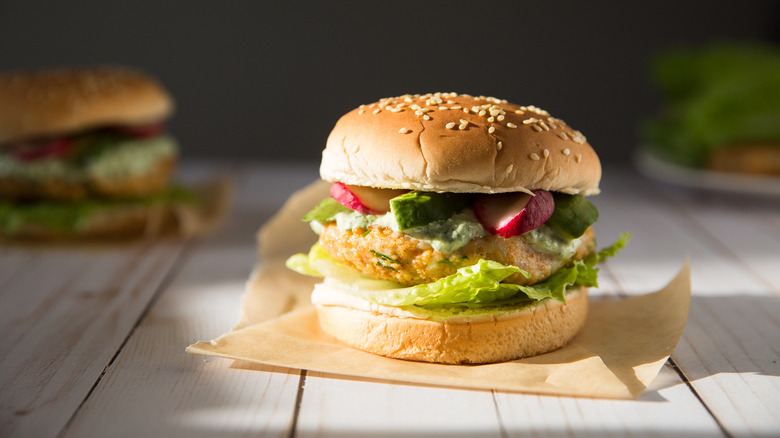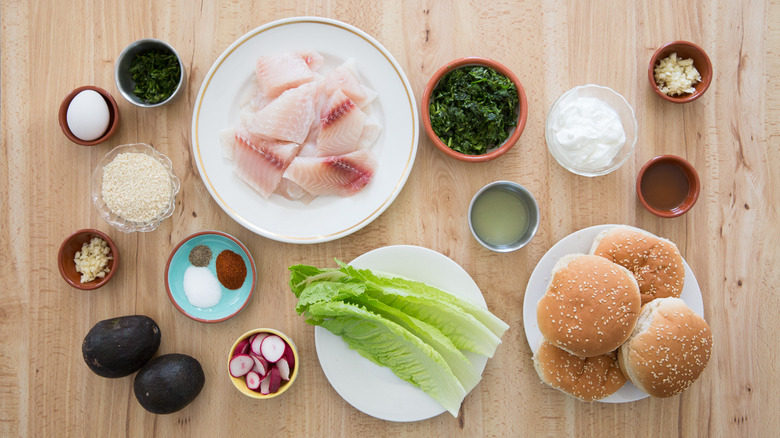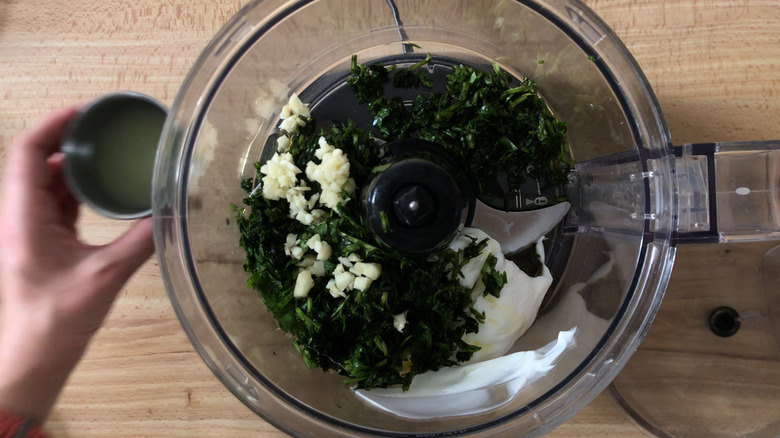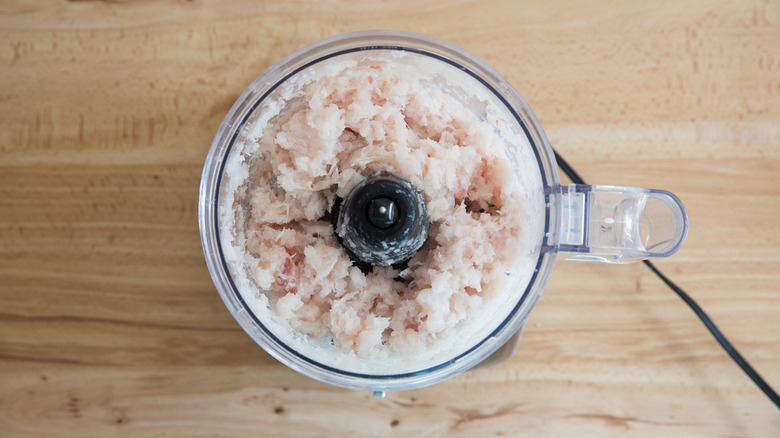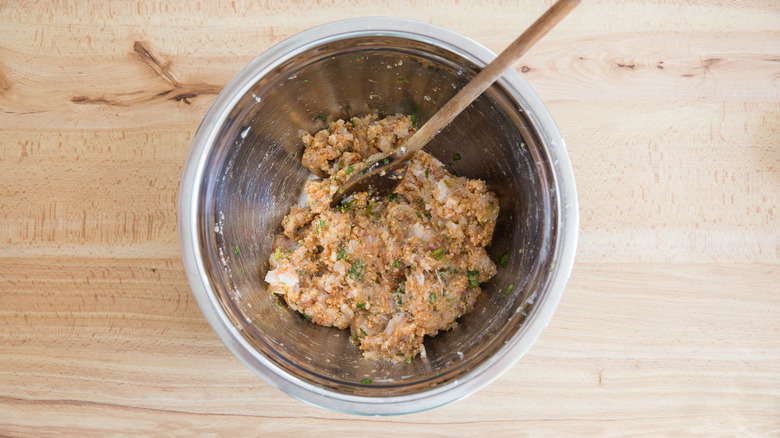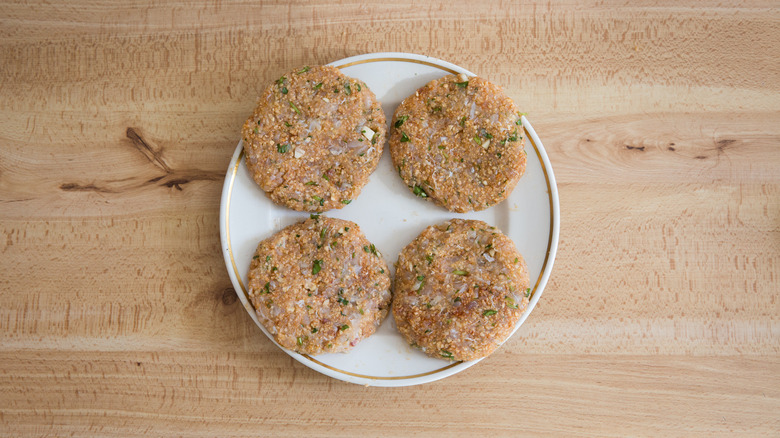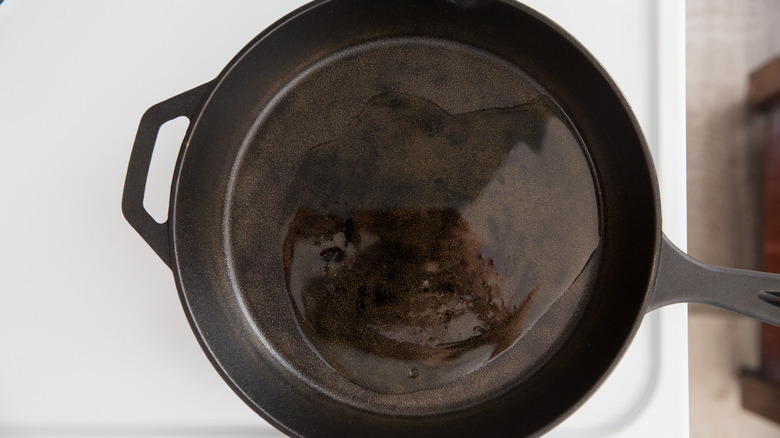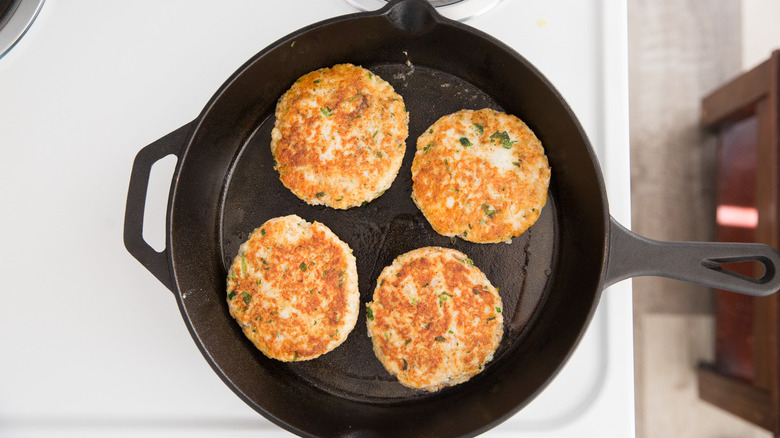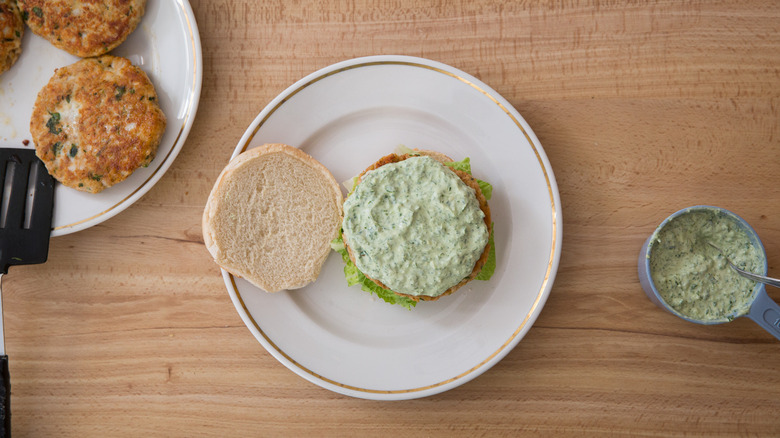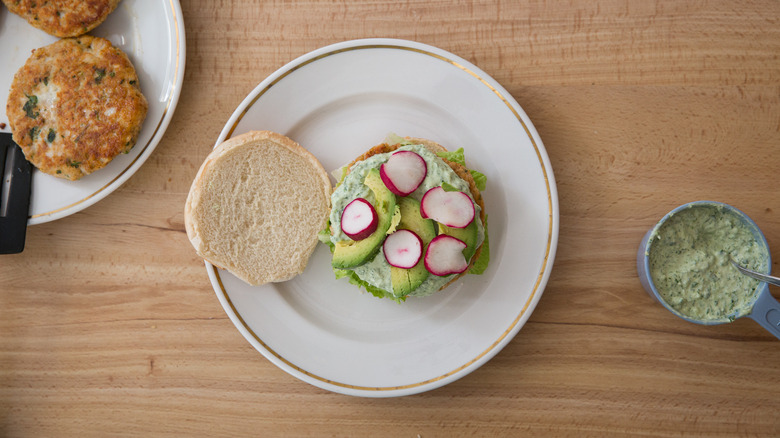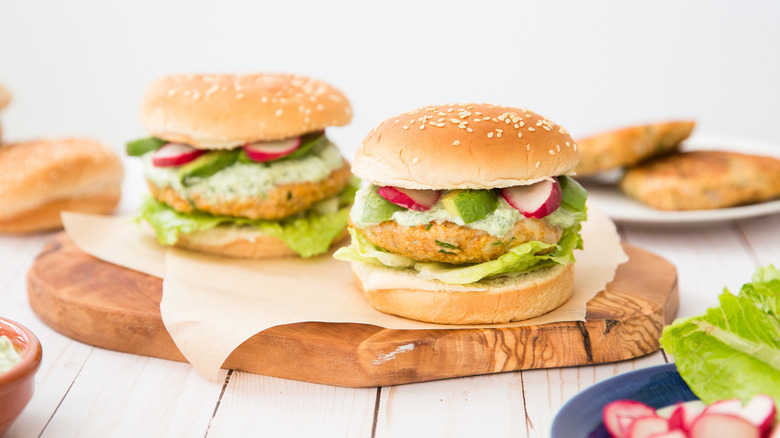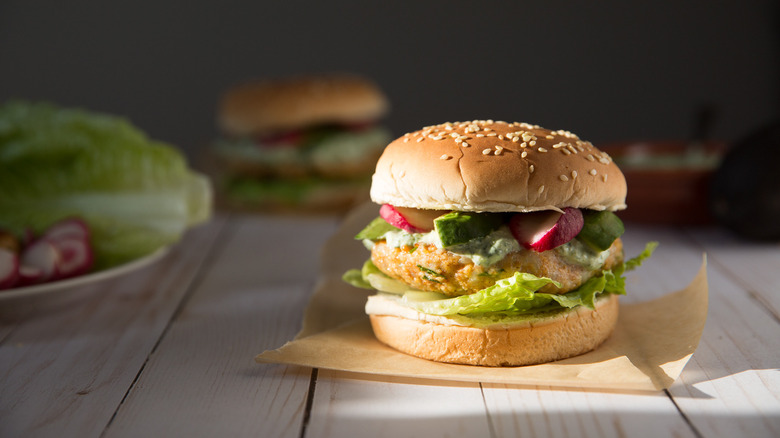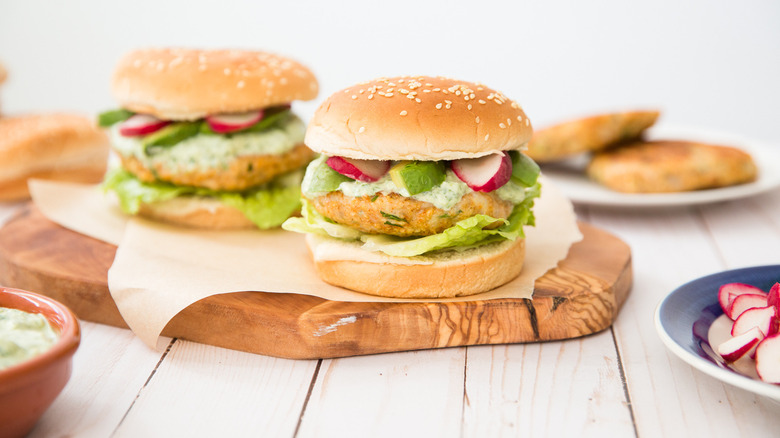Cilantro-Lime Tilapia Burgers Recipe
The FDA recommends that adults consume at least 8 ounces of fish per week, citing benefits such as increased heart and bone health, as well as a reduction in obesity and certain cancers. If you struggle to find ways to include fish in your diet, making fish burgers could be a tasty way to eat more. If you regularly consume fish, this could be a fun new recipe to add to your repertoire.
Recipe developer Michelle Bottalico has created a recipe for tilapia burgers inspired by the flavors of Latin America. "I traveled to Guatemala three times and enjoyed several delicious tilapia and other fish dishes there," Bottalico says. "The spices and toppings they used gave me ideas for how to add more interest and a brighter flavor to a fish burger." Cilantro and paprika are added to the patties, while lime juice and more cilantro mix with Greek yogurt and other ingredients to make a delectable, creamy cilantro-lime sauce to spread on the burgers. Before serving, the burgers are topped with lettuce, radish, and avocado.
While the recipe is written for tilapia, most kinds of mild white fish, including flounder, cod, haddock, and snapper, would also work well. The recipe makes four large burgers, but you can opt to make six smaller ones if you like. Try this recipe if you're looking for a versatile fish recipe to serve at anything from a weeknight dinner to a backyard cookout.
Gather your cilantro-lime tilapia burger ingredients
For the burgers, you will need 1 pound of tilapia. Cut the fish into large pieces so it can be chopped in a food processor with the other ingredients, which are panko breadcrumbs, an egg, garlic, cilantro, paprika, salt, and black pepper. Grab some olive oil for frying the patties, as well. The cilantro-lime sauce calls for Greek yogurt, and you can choose yogurt with any percentage of fat you like. Cilantro, garlic, olive oil, lime juice, and salt are the other sauce ingredients you'll need. Have some hamburger buns on hand for serving, as well as lettuce, radishes, and avocado for topping.
Step 1: Make the sauce
Make the cilantro-lime sauce by adding all of the ingredients to a food processor or blender and blending until mixed.
Step 2: Chop the tilapia
Place the tilapia in a food processor and pulse until chopped. If you don't have a food processor, you can cut the fish into small pieces with a sharp knife or kitchen scissors, but you may need more breadcrumbs to bind the patties.
Step 3: Prepare the patty mixture
Transfer the tilapia to a large bowl, add the breadcrumbs, egg, garlic, cilantro, paprika, salt, and pepper, and mix well. Roll a small amount into a ball to test it — if it doesn't stick together well, add a little more breadcrumb until it does.
Step 4: Form the patties
Form the mixture into 4 large patties, pressing them tightly into shape.
Step 5: Heat the oil
Heat the oil in a large skillet — preferably cast-iron — on medium-high heat.
Step 6: Cook the patties
Place the patties in the pan and cook for 4–5 minutes on one side, then flip them and cook for 3–4 minutes on the other side until both sides are browned and crispy. Do this in batches if you have a small pan.
Step 7: Start assembling the burgers
Place one lettuce leaf on the bottom of each hamburger bun, then top each with a burger. Spread cilantro-lime sauce on top.
Step 8: Add the toppings
Top the burgers with thinly sliced radish and sliced avocado.
Step 9: Serve your cilantro-lime tilapia burgers
Serve immediately.
Can I make cilantro-lime tilapia burgers with a different kind of fish?
Tilapia is a popular white fish with a mild taste, firm texture, and a more affordable cost that works well for these burgers. The taste doesn't overpower the burger, and it plays well with the other ingredients. However, some people may prefer to use a different fish for this recipe. Although the FDA calls tilapia one of the best fish to eat for its low mercury content, others may think twice before buying certain farm-raised tilapia because of environmental and other issues.
Luckily, almost any kind of fish filet will work well in these burgers. Cod, branzino, salmon, catfish, mahi mahi, haddock, snapper, flounder, and sole are all options. Since the fish is chopped and mixed with other ingredients rather than eaten alone, you don't have to break the bank with your choice of fish; choosing what is available or affordable is fine. Another option, especially if you don't have a good source of fresh fish or frozen fish, is to use drained water-packed tuna.
Can I bake cilantro-lime tilapia burgers in the oven?
This recipe calls for pan frying the tilapia burgers in a heavy skillet like a cast-iron skillet. While the pan frying method produces a great result, some people may prefer to bake their burgers instead of frying them. Baking also produces a tasty burger, and it can be a way to reduce the amount of oil used if that is a concern. Baked recipes usually call for greasing a baking sheet as well as drizzling oil on one or both sides of the burgers before cooking them. You can cut down on the oil by lining a baking sheet with parchment paper and lightly spraying both sides of the burgers with cooking spray instead of spooning oil onto them.
Before baking, prepare the burgers as the recipe indicates. Preheat the oven to 450 F and cook the burgers for 15–20 minutes, flipping them halfway through. You can opt to bake them at 350 F for 40 minutes if you prefer, again flipping them at the halfway point. You can also choose to broil your fish for a crispy crust, if desired. Place them under the broiler for 1–2 minutes per side after baking.
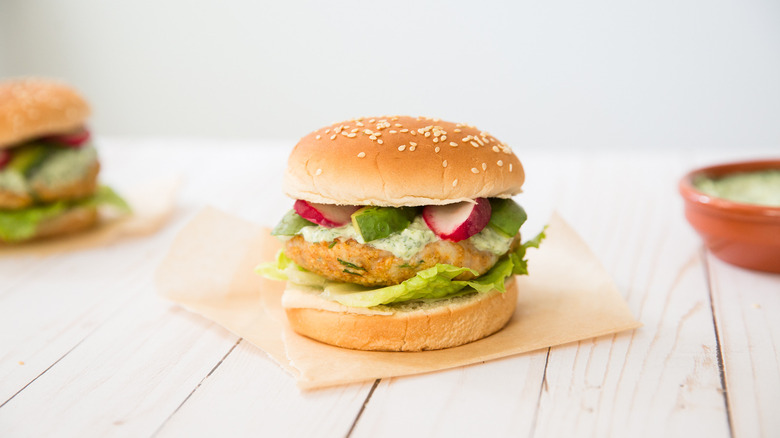
- For the cilantro-lime sauce
- ½ cup Greek yogurt (any percentage fat)
- ¼ cup + 2 tablespoons roughly chopped cilantro
- 1 clove garlic, minced
- ½ tablespoon olive oil
- 1 tablespoon lime juice
- ⅛ teaspoon salt
- For the burgers
- 1 pound tilapia, cut into large pieces
- ½ cup panko breadcrumbs
- 1 large egg
- 1 large clove garlic, minced
- 2 tablespoons minced cilantro
- 1 teaspoon sweet paprika
- 1 teaspoon salt
- ¼ teaspoon black pepper
- 1 tablespoon olive oil
- For serving
- 4 hamburger buns
- 4 lettuce leaves
- 4 small radishes, thinly sliced
- 2 small avocados, sliced
- Make the cilantro-lime sauce by adding all of the ingredients to a food processor or blender and blending until mixed.
- Place the tilapia in a food processor and pulse until chopped. If you don't have a food processor, you can cut the fish into small pieces with a sharp knife or kitchen scissors, but you may need more breadcrumbs to bind the patties.
- Transfer the tilapia to a large bowl, add the breadcrumbs, egg, garlic, cilantro, paprika, salt, and pepper, and mix well. Roll a small amount into a ball to test it -- if it doesn't stick together well, add a little more breadcrumb until it does.
- Form the mixture into 4 large patties, pressing them tightly into shape.
- Heat the oil in a large skillet -- preferably cast-iron -- on medium-high heat.
- Place the patties in the pan and cook for 4–5 minutes on one side, then flip them and cook for 3–4 minutes on the other side until both sides are browned and crispy. Do this in batches if you have a small pan.
- Place one lettuce leaf on the bottom of each hamburger bun, then top each with a burger. Spread cilantro-lime sauce on top.
- Top the burgers with thinly sliced radish and sliced avocado.
- Serve immediately.
| Calories per Serving | 480 |
| Total Fat | 23.2 g |
| Saturated Fat | 4.9 g |
| Trans Fat | 0.0 g |
| Cholesterol | 108.0 mg |
| Total Carbohydrates | 36.7 g |
| Dietary Fiber | 6.5 g |
| Total Sugars | 5.4 g |
| Sodium | 719.6 mg |
| Protein | 33.9 g |
